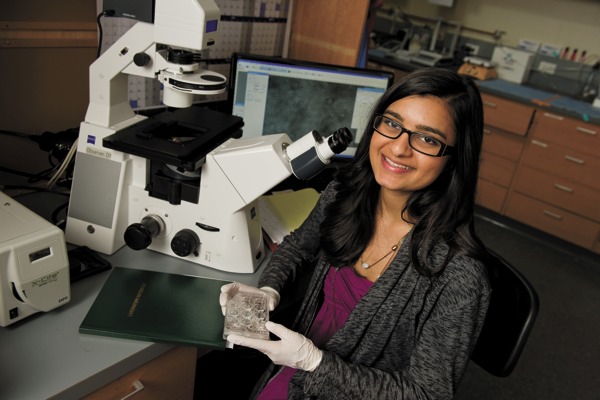April 11, 2011
Looking for the cause of preeclampsia

Millie Shah is probing the cellular imbalances that may trigger preeclampsia. Photo: Will Kirk/Homewoodphoto.jhu.edu
Name: Millie Shah
Age: 20
Hometown: Fullerton, Calif.
Major: biomedical engineering, Whiting School of Engineering
Faculty sponsor: Feilim Mac Gabhann, assistant professor of biomedical engineering, Whiting School of Engineering
Project title: “Computational Modeling of VEGF and sFlt-1 to Stimulate Preeclampsia and Evaluate Treatments”
For many women, pregnancy proceeds smoothly. But a small percentage of expectant mothers develop preeclampsia, a medical condition that can cause serious harm to both the mother and the fetus. For her PURA project, junior Millie Shah decided to probe the cellular imbalances that may trigger this disease. Working in the lab of Feilim Mac Gabhann, an assistant professor of biomedical engineering, Shah has been using a computer model that mimics the biological activity linked to preeclampsia. She has also spent time in the wet lab, making sure her computer results resemble what happens to cultured living cells. Her findings could lead to new ways to detect, treat or even prevent the disease.
Questions for Millie Shah:
What is preeclampsia, and how common is it? Preeclampsia is a disease that is not well-understood. We don’t know if it’s hereditary or a disease caused by environment, health or some other factor in the mother’s upbringing. But we do know that preeclampsia occurs worldwide in 5 [percent] to 8 percent of all pregnancies.
Does preeclampsia endanger the mother? The developing fetus? Preeclampsia can harm both the mother and the fetus. In the mother, it is characterized by high blood pressure and excessive protein in the urine. If the condition persists, the mother can develop eclampsia, leading to seizures, comas and even death.
Preeclampsia can disrupt the normal growth of the fetus, leading to a preterm delivery. It can also cause kidney failure and bleeding in the mother’s brain. The Preeclampsia Foundation says that by conservative estimates, preeclampsia and related disorders are responsible for 76,000 maternal and 500,000 infant deaths each year.
If we can figure out what causes preeclampsia, this could open the door to new, more-effective treatments, and perhaps even a way to prevent the disease from happening in the first place.
How does your PURA project address this? I’ve been looking for the earliest biological signals that indicate that this disease is developing in a pregnant woman. If we find them, then doctors may be able to test for these disease markers at an early point in the pregnancy. If the disease is detected at a very early stage, then monitoring and treatment of the mother and fetus can begin right away.
What exactly are you focusing on? As I mentioned, researchers are still not sure what causes preeclampsia. But the leading theory is that inside the developing placenta there is an irregularity in the release of proteins that either cause the growth of new blood vessels in the fetus or suppress this process. Our lab’s hypothesis is that too much of a protein called sFlt-1 is being produced and it acts like a sponge, soaking up a different protein that stimulates the growth of blood vessels. The result is that the normal growth of blood vessels is suppressed, and this imbalance ultimately triggers preeclampsia.
For my PURA project, I’ve developed a computer model that depicts the activity of these proteins that stimulate or suppress the growth of blood vessels in order to test our ideas about how they are linked to preeclampsia. We are using this model to determine whether monitoring these proteins could be used for early diagnosis, prevention or treatment of preeclampsia. In the lab, I’m also testing my results on cultured living cells to make sure that what’s happening in the computer matches what’s happening in the real world. I’m still awaiting the final results of these experiments.
What were the most important things you learned while working on this project? I learned that organization is key, and collaboration makes all the difference. It’s always a good idea to stay organized and constantly remind yourself what the bigger picture is and plan accordingly. I found that my research could become very complicated very quickly, and if I didn’t remind myself of the overall goal, I would get lost in the finer details. I also learned a lot about working with other people and how asking for help only strengthens a project. I received a lot of help from everyone in the lab, particularly Professor Mac Gabhann and postdoctoral fellow Yasmin Hashambhoy, who shared their expertise on the computational side, and from Elizabeth Logsdon, who is also a postdoctoral fellow, for her expertise on the wet lab/in vitro side. Without this aid, my project would definitely not have worked out as well as it did.
Do your friends ever tease you about spending way too much time with computers and not nearly enough time with living, breathing life-forms? No, they don’t, thank goodness. My parents on the other hand … no, just kidding. Both my friends and family are really supportive.
Could you next develop some software that would figure out how to keep babies from screaming in restaurants? Unfortunately, probably not. However, I can suggest some treatment options for you: One, feed them; or two, change their diapers!
Sponsor Feilim Mac Gabhann says:
Millie is outstanding. Along with natural talents such as being smart, incisive and productive, she has all of the qualities needed to be a great researcher: She thinks deeply about the underlying questions, she always has ideas for what comes next, she takes the initiative to follow ideas and try techniques that could improve the research, and she communicates her work in a clear way that facilitates discussion. Millie is also an excellent photographer, and this creativity is evident in her research, too. She has made great progress in her study on preeclampsia.

